From 1997’s “Halloween Rain” through 2008’s “One Thing or Your Mother” — and with the bonus of Kiersten White’s “Slayer” duology in recent years — the Buffyverse tie-in novels gave us a way to escape into the world of Slayers and vampires between WB New Tuesdays and after the shows went off the air.
But with nearly 100 original “Buffy” and “Angel” novels out there (more if you count novelizations of episodes), it can be intimidating to figure out where to start.
There’s gold among the “Buffy” bookshelf, and while you’re usually safe with anything by Christopher Golden, you might want a more definitive guide to the stacks to avoid the duds.
As such, I’ve gone into research mode to come up with my picks for the 20 best “Buffy” and “Angel” novels and short-story collections, listed in roughly chronological order of the Buffyverse timeline:

“Tales of the Slayer, Volume 2” (2003)
The first volume is solid, but this is where the “Tales of the Slayer” series finds its identity as a journey through times and places of yore with Slayers as our guides. Learning about past Slayers makes history fun enough that even Buffy could absorb some knowledge. Highlights include a Southern belle reinventing herself in the Roaring Twenties in the Big Apple, a hardboiled detective Slayer solving a case in 1940s Chicago, and a Victorian-era Slayer matching wits with Dracula. Plus, TV staffer Jane Espenson delivers a lump-in-your-throat nostalgia piece about a mature Buffy transported back to her high school years. (Full review.)
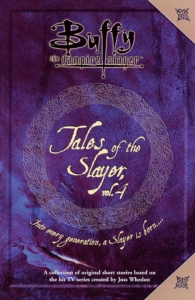
“Tales of the Slayer, Volume 4” (2004)
The final “Tales” volume centers on the Cruciamentum, and it’s not as repetitive as one would fear; the writers find a variety of angles into the Watchers Council’s barbaric practice of stripping Slayers of their powers and testing them against a vampire. Highlights include an evocative piece in a sweltering Chicago summer on the eve of Prohibition, a harrowing trek through the Spanish Inquisition that shows human evil can stand toe-to-toe with the demonic variety, and a beat-poet-style piece about a rare Watcher-turned-vampire. (Full review.)
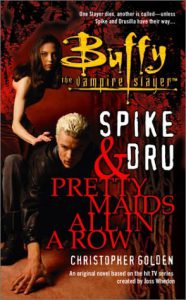
“Spike and Dru: Pretty Maids All in a Row” (2000)
By Christopher Golden
The World War II-set “Pretty Maids” is like a superior version of the Season 7 story of Potentials being hunted around the world, offering a scope not found on modestly budgeted TV. In this case, the hunters are the titular vampires, who we often root for — especially when they are draining Nazis. That said, these Potentials (a.k.a. “Slayers in Waiting”) are also likeable; brave Sophie and timid Eleanor are drawn better than the batch we meet in Season 7. Golden’s near-masterpiece is kept from perfection only because of a communication glitch between Mutant Enemy and the author that results in Spike killing a bonus Slayer. (Full review.)

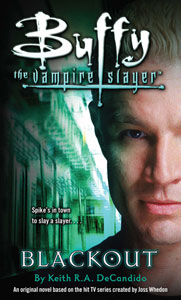
“Blackout” (2006)
By Keith R.A. DeCandido
As both the afterword and the passionate prose make clear, the summer of 1977 in New York City is close to the heart of the author, who was a kid during the time of the blackout, looting, a heat wave and economic unrest. DeCandido channels his intimate knowledge of the period through young Nikki the Vampire Slayer, who patrols her neighborhood like Marvel’s Luke Cage. Spike is in fine form, strutting around and doling out punishment to lesser vamps who don’t know what they’re in for. Despite our knowledge of how this has to end, the tension is not lessened, and the poignancy of Nikki’s death is actually heightened. Continuity mistakes in relation to Nikki’s story in “Tales of the Slayer, Vol. 4” are all that keep “Blackout” from perfection. (Full review.)

“How I Survived My Summer Vacation” (2000)
In six linked short stories, we get a wonderful time capsule of the summer of 1997, an era slightly before cellphones and easy computer access when you could actually miss your friends. Without sacrificing Buffy’s distant attitude toward her dad or Xander’s claim of an uneventful summer, the authors carve out tales that illustrate where everyone is at after the life-changing events of Season 1. (Full review.)

“Go Ask Malice: A Slayer’s Diary” (2006)
By Robert Joseph Levy
In the early days of the spin-off novels, Faith was off limits, so it took awhile before we got great stories about the rogue Slayer, but this definitive entry was worth the wait. First, you have to buy into the notion that Faith keeps a diary, but you’ll be glad she does, because she’s a darn good storyteller. “Go Ask Malice” bounces from indie-film grit to haunted-house horror to nightmare logic as Faith gradually becomes the complicated gal we meet in “Faith, Hope and Trick.” As happens too much in the tie-in novels, there are some continuity hiccups (namely, Faith’s dad’s name and backstory would be changed for the “Angel & Faith” Season 9 comics), but if you want to learn what makes Faith tick, you’ll be five-by-five after reading this one. (Full review.)
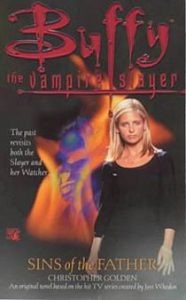
“Sins of the Father” (1999)
By Christopher Golden
This surprisingly deep Giles-focused story set during Season 3 finds the Watcher confronted by his father, who is a vampire. It may have inspired the “Angel” episode “Lineage,” where Wesley reunites with his father, who turns out to be a robot. Similarly, this villain turns out to not truly be Giles’ father (something so earth-shattering for a main character can’t occur in spinoff fiction), but the emotions and horror are real for Giles. Meanwhile, Pike (from the movie and “The Origin” comic) pops up in Sunnydale, and his lack of interest in being a Scooby provides a nice foil for Buffy’s newer, more loyal friends. (Full review.)
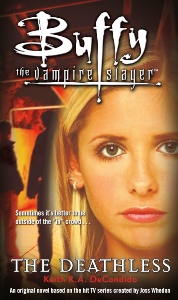
“The Deathless” (2007)
By Keith R.A. DeCandido
For several entries on this list, I have to mention continuity errors in relation to the TV series, but “The Deathless” is the best “Buffy” book that also fits snugly into the continuity. It could be episode 3.13.5 not only because it fits there, but also because it’s good enough to be a Season 3 “Buffy” episode. DeCandido delivers engrossing fable-style flashbacks about the villain-of-the-week while giving spot-on characterizations of everyone from Principal Snyder to Faith, and also building up magic-using Michael into a second-string Scooby. It’s a shame DeCandido only wrote two original “Buffy” books, because he’s a master of the form. (Full review.)

“Redemption” (2000)
By Mel Odom
It’s a common template in an “Angel” novel for a person from Angelus’ past to haunt Angel, but this is a standout example as Odom keeps the juicy mystery about the seemingly ageless Moira’s identity going for quite a while. The author predicts several elements the TV series would later get to, including vampire hunters. Angel, gambling addict Doyle and Hollywood hopeful Cordelia are all in vintage form with their own redemption arcs as they find their footing at the newly founded Angel Investigations. (Full review.)
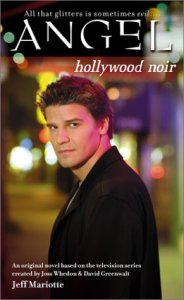
“Hollywood Noir” (2001)
By Jeff Mariotte
This is the literary version of “Angel” at its finest. Mariotte leans into the hardboiled style via literally out-of-time gumshoe Mike Slade, and what’s more, the AI gang is in prime noir form with Angel doling out assignments, Doyle manning a stakeout and Cordelia acting as a femme fatale. The case gets into the weeds of Los Angeles political/corporate corruption, yet “Hollywood Noir” is ultimately a poignant statement about the lonely lifestyle of private eyes. (Full review.)

“Bruja” (2001)
By Mel Odom
This story named after La Llorona of Mexican folklore (also featured in a “Conjuring” Universe film) takes place at a particularly busy time for Angel, Doyle and Cordelia, as four cases overlap. Our gumshoes pound the pavement all over Odom’s wonderfully lived-in L.A., with Cordy probing a swanky party and Doyle receiving a “Chinatown”-type beating. Angel, meanwhile, brings his brooding A-game as aspects of this case remind him of his murder of his own family. (Full review.)
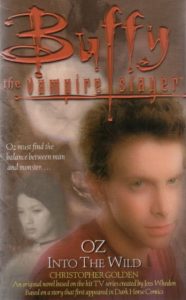
“Oz: Into the Wild” (2002)
By Christopher Golden
Oz is a chill companion for the reader on this travelogue of his worldwide journey to seek a way to control his lycanthropy in Season 4. Continuity gurus should be warned that this story was later overwritten by the canonical Season 8 arc “Retreat,” but the new version does retain the Tibet location and Eastern mysticism that Golden introduces here, and potential love interest Jinan is the placeholder for Oz’s canonical wife, Bay. Ultimately, “Into the Wild” is Oz’s “The Zeppo” — a story where we see he is as much of a hero as those who get more attention. But true to his nature, he’s not going to stand around and talk about it all day. (Full review.)
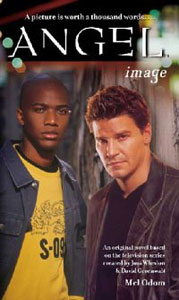
“Image” (2002)
By Mel Odom
The delicious Angelus-and-Darla exploits in the 19th century intriguingly include their time as houseguests of Mary Shelley, the writer of “Frankenstein.” The whole AI team shines in the present-day story, from Gunn getting involved with a mysterious woman to Cordy and Wes getting into hijinks with the sniveling informant demon Merle. “Image” boasts humor, history and high-stakes tension, making it the best of the post-Doyle “Angel” novels. (Full review.)
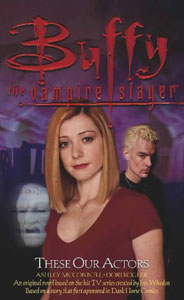
“These Our Actors” (2002)
By Ashely McConnell and Dori Koogler
Thanks to the later revelation that Cecily and Halfrek are the same person, this now stands as an alternate-reality story, but in my opinion it’s the “Fool for Love” sequel that should’ve been. Spike’s death wish on the woman who broke his heart is obviously a step too far, but his thirst for revenge is emotionally real — and hey, he’s a soulless vampire. The theater-based mystery at UC-Sunnydale is also engaging, as Willow appropriately shies from the spotlight and works backstage to help Spike figure out a blast from his past. (Full review.)
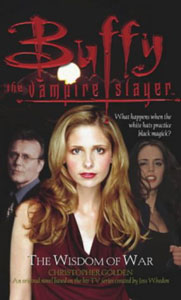
“The Wisdom of War” (2002)
By Christopher Golden
Golden nails Faith’s characterization and speech in his first crack at writing the rogue Slayer in this Season 5-set epic. While it has continuity issues such as Spike and Faith meeting (in their real bodies) prior to Season 7, “The Wisdom of War” — as its title suggests — includes our heroes’ meaty pontifications about the merits of taking a stab at diplomacy versus simply stabbing demons. As he does in many of his novels, Golden digs into the Watchers’ Council to a degree not seen on the TV series, introducing the moderate spinoff group The Order of Sages. (Full review.)
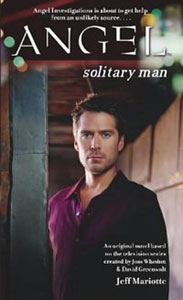
“Solitary Man” (2003)
By Jeff Mariotte
This is set during “Angel” Season 4, when everyone is on the outs; indeed, cover boy Wesley is a candidate for being the titular loner. The author reminds us of this but doesn’t dwell on it; the story comes first, and it’s a creepy one about an ancient demon looking to assemble two artifacts to regain his power. If not for The WB’s youth-oriented mandate of the time, I can totally see Mildred Finster applying at Angel Investigations. As her name suggests, she’s a spry spinster who wants to apply her knowledge of Agatha Christie mysteries to real-world cases. (Full review.)
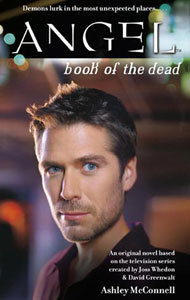
“Book of the Dead” (2004)
By Ashley McConnell
Through Wesley and one of his old Watcher’s Academy mates, McConnell pens a love letter to books. Ironically, considering what a page-turner this is, the central danger to Wesley is that he’ll literally get lost in a book (and consumed by the villainous Bookwyrm). While the threat is serious, this Season 4-set yarn also features one of the most amusing passages in an “Angel” book. Wesley introduces his stuffy colleague to the Angel Investigations gang without warning him beforehand of their various attributes, such as Angel being a vampire. (Full review.)
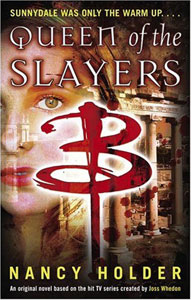
“Queen of the Slayers” (2005)
By Nancy Holder
This “Harry Potter”-style yearlong adventure has since been contradicted by the canonical comics, but it nonetheless stands as a fascinating path not taken as we find out what the Scoobies are up to during the time of “Angel” Season 5 (the first year of “Buffy” being off the air). Holder tackles many issues the official stories would later explore, including the freedom of Slayers to join or not join Buffy’s group, the reorganizing of the Watchers in the wake of the headquarters bombing, and Buffy’s internal Angel-or-Spike debate. The Immortal, Buffy’s supposed boyfriend, would be turned into a punchline in the comics, but here he’s a fascinating enigma operating in the gray area between good and evil. (Full review.)

“Dark Congress” (2007)
By Christopher Golden
As with “Queen of the Slayers,” this is an alternate-universe story as Golden attempts to link “Queen” with the Season 8 comics, which launched around this same time. It’s ultimately a futile task, but “Dark Congress” remains a great “what if” yarn. Its biggest strength is that it crafts a poignant goodbye for Willow and Tara, something the TV show intended to do in “Conversations with Dead People” before it replaced Tara with Cassie in the final teleplay. Other than the “Slayer”/”Chosen” duology, this is the only book to reference the events of the canonical comics. (Full review.)
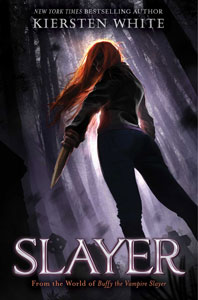
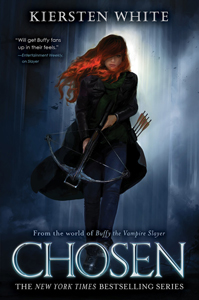
“Slayer” (2019) and “Chosen” (2020)
By Kiersten White
Wildly unlike any other books on this list, White’s Ireland-set duology is written in the young-adult style of the 2010s, and with a modern sensibility toward diversity (even though it takes place between Seasons 8 and 9, at the start of the decade). Nina the Vampire Slayer and her sister, Artemis (who gets some POV chapters in “Chosen”), are incredibly introspective, which isn’t to all readers’ tastes, but if you can get into the flow, this is tasty stuff. A handful of natural and delightful tie-ins to familiar faces and events helps to ground White’s unique perspective in the wider Buffyverse. (Full reviews of “Slayer” and “Chosen.”)
Click here to visit our “Buffy”/“Angel” Zone.
Related: John’s top 20 “Buffy” episodes

